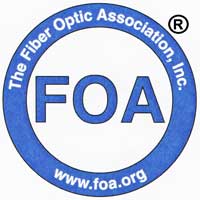

July 2022
|
Search the FOA website
FOA Home Page
Contact
Us
|
Sign
up for the FOA eMail Newsletter
Privacy Policy
Sections
News
Technical
Worth
Reading Q&A
Training/FiberU
Resoures
Safety
About
|
- Note we have
changed the format to place articles in
sections on one topic and all articles are
dated so you know if we repeat one - which
we often do when we think it's very
important!
More FOA Guides For Color Codes
The First "Terabit City"
Certified Techs To Build Broadband
Fiber Optic History - The Movie
Everyone Uses Fiber U
Cross Reference To FOA Tech
Newsletter Sections
Click
on any link to jump to that section
News
Broadband Funding Expands in Kentucky
Peabody HS Graduates First CFOT
IMSA Convention Hosts CFOT Fiber Training
New Teaching Tool Helps Train W4W
Beaver Causes Fiber Outage
Technical
Useful New Products
Maintaining A Fiber Optic Cable Plant
Interpreting Specs For Cable Plants
Mobile App Collects Fiber Test Data
Aerial Cables - Good & Bad
Warning For Techs About Fiber Amplifiers
FOA Online Loss Budget Calculator
Worth
Reading Lots of interesting
articles
Q&A
Questions from our readers
Training/FiberU
New FOA-Approved Schools, Fiber U
MiniCourses, more
Resources
New FOA YouTube Videos.
Safety
About the FOA
FOA Certified Techs:
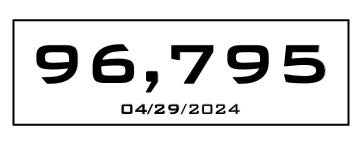
Time
To Renew Your FOA Certifications?
Special offer - 1/3
Off Renewal
Jobs
- See FOA Jobs
Web Page and FOA on

- The FOA Jobs
Web Page has been updated and a new page added
on Using your FOA
Training/Certification to Find the Right Job
in Fiber Optics
Where
Are The Jobs In Fiber Optics? FOA talks about
all the applications for fiber optics, what jobs
involve and the qualifications for the workers in
the field in this YouTube video.
Join The FOA eMail Newsletter
List
Want
to be notified when the FOA Newsletter is updated? Sign
up for the FOA eMail Newsletter. You can
also sign up from your cell phone: text "FOA" to
22828 (usual text message charges apply)
Trademarks:
The FOA CFOT® (Certified Fiber Optic Technician) and
Fiber U® (the FOA online self-study program) are
registered trademarks of the FOA.
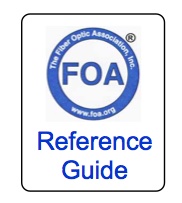
Want to know more about fiber optics? Study
for FOA certifications? Free
Self-Study Programs are on "Fiber U®."
Looking for specific information? Here's the largest
technical reference on the web: The
FOA Online Fiber Optic Reference Guide.
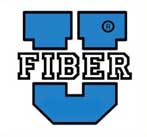
Free online self-study programs
on many fiber optics and cabling topics are
available at Fiber U,
FOA's online web-based training website.
FOA
Reference Books
Available Printed or eBooks
The fiber book is
available in Spanish and French
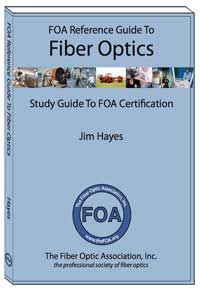 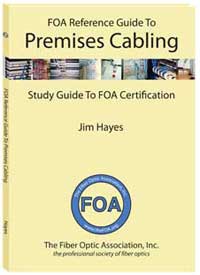 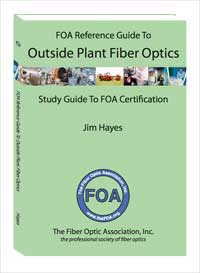
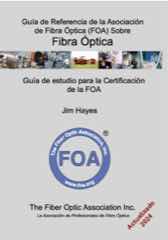
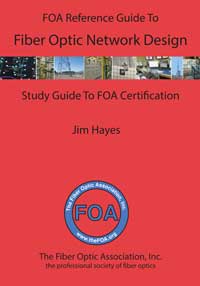 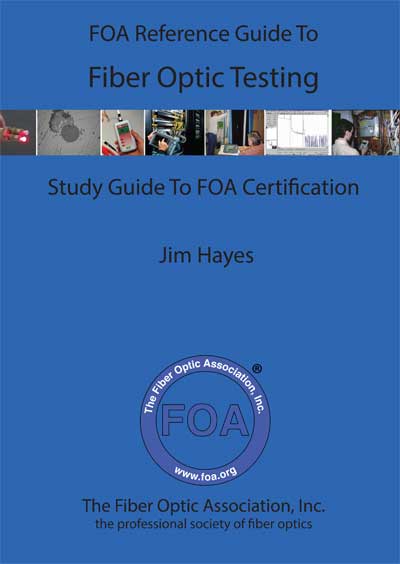
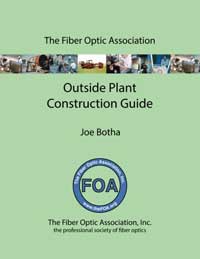 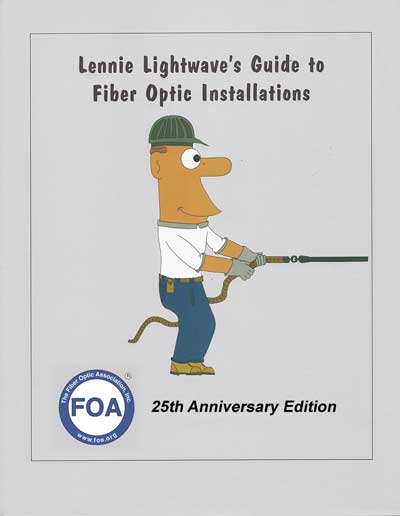
Lennie
and Uncle Ted's
Guides are now also available as free iBooks on
iTunes.
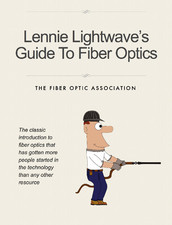
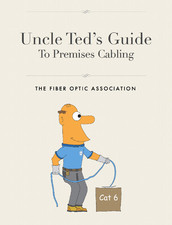
Click on any of
the books to learn more.
- Fiber
Optic Safety Poster to download and
print
FOA Videos on 
FOA
is a member of:




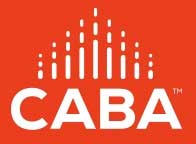
The FOA Newsletter is
edited by Jim Hayes - send your stories, leads,
ideas, comments to <jim @ foa.org>

Search the FOA Website With
DuckDuckGo
Top Stories From The 2021 FOA Newsletters
- The Archives: Past
Issues.
- Use these links to
read past issues or use FOA's
Custom Search to look for specific
topics on our website.
1/22, 2/22, 3/22, 4/22, 5/22, 6/22, 7/22,
1/21, 2/21. 3/21, 4/21, 5/21, 6/21, 7/21, 8/21, 9/21, 10/21,
11-12/21,
1/20,
2/20,
3/20.
4/20,
5/20,
6/20,
7/20,
8/20,
9/20,
10/20,
11/20,
12/20,
1/19,
2/19,
3/19,
4/19, 5/19, 6/19, 7/19, 8/19, 9/19,
10/19,
11/19,
12/19
1/18,
2/18,
3/18, 4/18,
5/18, 6/18, 7/18, 8/18, 9/18, 10/18,
12/18.
1/17, 2/17, 3/17, 4/17, 5/17, 6/17,
7/17,
8/17,
9/17,
10/17, 11/17,
12/17
1/16, 2/16, 3/16,
4/16,
5/16,
6/16,
7-8/16,
9/16,
10/16,
11/16,
12/16
1/15,
2/15,
3/15,
4/15,
5/15,
6/15,
7/15,
8/15,
9/15 ,
10/15,
11/15
, 12/15
1/14,
2/14,
3/14,
4/14,
5/14,
6/14,
7/14,
8/14,
9/14,
10/14,
11/14,
12/14
1/13,
2/13,
3/13,
4/13,
5/13, 6/13,
7/13,
8/13,
9/13,
10/13,
11/13,
12/13
1/12
, 2/12,
3/12,
4/12,
6/12,
7/12,
8/12,
9/12,
10/12,
11/12,
12/12
1/11 ,
2/11,
3/11,
4/11,
6/11,
7/11,
8/11,
9/11, 10/11,
11/11,
12/11,
1/10 ,
2/10,
3/10,
4/10,
05/10,
07/10,
08/10,
09/10,
10/10,
11/10
1/09 ,
2/09,
3/09,
04/09,
05/09,
07/09,
08/09,
09/09,
10/09, 11/09,
12/09
1/08 , 2/08, 3/08, 4/08, 5/08, 6/08, 7/08, 8/08, 09/08, 10/08, 11/08, 12/08
12/07 , 11/07, 10/07, 09/07, 08/07, 07/07, 06/07, 05/07, 04/07, 03/07, 2/07, 1/07
12/06 , 11/06, 10/06, 09/06, 8/06, 7/06, 6/06, 5/06, 4/06, 3/06, 2/06, 1/06,
12/05 ,11/05, 10/05, 09/05, 08/05, 07/05, 6/05, 5/05, 4/05, 2/05, 01/05,
12/04 , 10/04, 9/04, 8/04, 7/04, 6/04, 5/04, 4/04, 3/04, 1/04,
12/03 , 11/03 10/03 9/03, 8/03, 7/03, 6/03, 3/03, 10/02 , 8/02, 5/02
Current Issue of FOA
Newsletter
Time To Renew Your
FOA Certifications?
To
keep your FOA certifications active, you need to
renew them when they expire. Now we have a new more
convenient way to renew - an online store at Paypal
- where you can quickly and conveniently use your
PayPal account or your credit card to renew your
certifications.
- You can now renew
with PayPal or a credit card
-
PayPal is available worldwide
Join FOA On
Social Media

FOA
has 3 LinkedIn Groups
FOA
- official page on LinkedIn - covers FOA, technology and jobs in the fiber optic
marketplace
FOA
Fiber Optic Training - open to all, covers
fiber optic technology and training topics
Grupo
de La Asociación de Fibra Óptica FOA (Español)
|
More Help On Color Codes (And More Free Stuff From FOA)
Last month we mentioned the FOA has created a pocket guide to fiber
optic color codes that we are sending to new and renewed CFOTs. It has
color codes for fibers and buffer tubes, connectors and premises cables
inside and on the back, QR codes to take you directly to the FOA Guide
and Fiber U.

The reaction was overwhelming. That's not surprising, as the FOA
Guide page on Fiber Optic Color Codes is one of the most read pages on the FOA
website and the Fiber Optic Color Codes minicourse on Fiber U very popular also.
And, unsurprisingly, we got lots of requests for the cards. While we
were sending them free to new and renewing CFOTs, we wanted to make them
available to everyone, but we're not prepared to fill all the requests
easily. So we came up with two alternate solutions.
Here's a do-it-yourself FOA Guide To Fiber Optic Color Codes card.
Just download the PDF file, print it on a color printer and fold it up
as shown. Then you have your own pocket guide to color codes. Make a
bunch for your co-workers too.
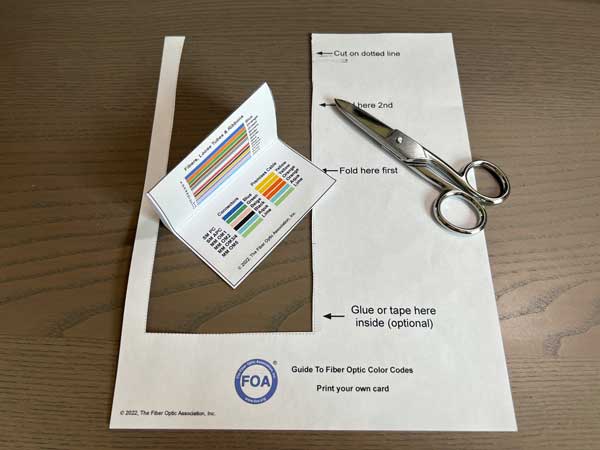 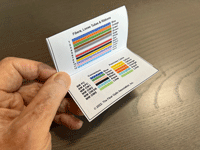
But we did not stop there. We know how many of you use your mobile devices on the job, so we created a version of the Color Code Guide you could download
and use on your smartphone or tablet. It's a PDF file, so you just
download it and save it on your device and it will be with you always.
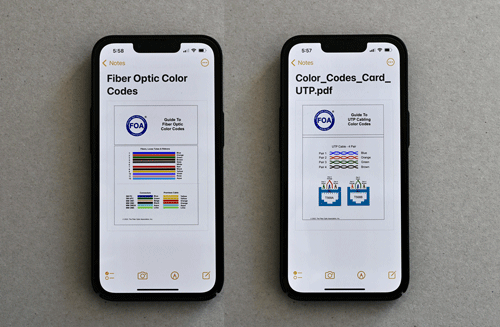
FOA Guides to Color Codes - Fiber (L) and UTP Copper (R)
Then we realized that many of your also do structured cabling
work, so it was a natural to add a Color Code Guide for UTP copper
cabling.
Here are the links to download your own FOA Guides to Fiber Optic Color Codes
FOA Guide to Fiber Optic Color Codes (print your own version) PDF
FOA Guide to Fiber Optic Color Codes (electronic version for your smartphone, tablet or PC) PDF
And For UTP Cabling
FOA Guide to UTP Cabling Color Codes (print your own version) PDF
FOA Guide to UTP Copper Cabling Color Codes (electronic version) PDF
Why Stop At Gigabits? Let's Design Fiber Networks For Terabits - It's The Future!
When discussing fiber infrastructure for cities, we mostly talk about
"Gigabit Cities," which are certainly the state of the art today. GPON
or 10GPON are the way to provide gigabit FTTH, and DOCSIS-3 or RFOG can
provide similar bandwidth for CATV systems. 5G and WiFi 6 wireless
promise almost as much bandwidth, although they are still unproven.
But fiber optic networks are good for 20-40 years at least, so what
happens as time moves on? Is Gigabit good enough? Based on past history
of the communications networks and the Internet, the answer is obvious,
of course not. So doesn't it make sense to design fiber optic networks
today that will be good in the future - the Terabit future?
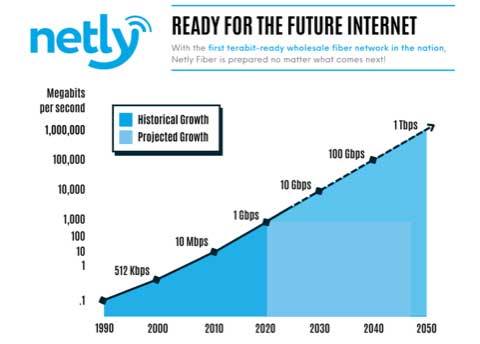
Graph of Internet speeds from Netly Fiber.
Another issue that makes sense is "open access." If the owners of the
fiber optic cable plant are not service providers, they can provide the
connections to the users and allow multiple ISPs, CATV companies,
telcos, etc. to colocate in their head end. If a customer wants to add
or change service providers, only a simple patchcord change is needed.
Open access networks are preferable for cities because it can allow more
flexibility in offering services to citizens and for the city's own
uses.
Can networks like this be built today? That's what a company called
Netly Fiber has done in Solana Beach, CA. In June 2022, Netly completed
their 2-year project of building a fiber network in Solana Beach that
shows that with some forethought, you can build "Terabit" fiber optic
networks today that should be good for the lifetime of the fiber.
(An aside: When Jack Demers, an entrepreneur in
wireless, got interested in fiber over 5 years ago, he called FOA
asking questions. He came to our office and spent most of a day
discussing the work we had done with FTTH, starting with helping Verizon
with FiOS and our recent work in the DIY projects like Southern
Fiberworx and Connect Anza. We discussed a lot of topics that day and
since then we have continued our conversations as Netly has gotten
started and begun operations. And, for full disclosure, your editor, JH, is a minor shareholder in Netly.)
What exactly is Netly doing that is different? The multi-million dollar
project took two years to complete and includes ultra-high speed dark fiber access for every residence, business, traffic light, and institution in the city.
To achieve terabit speeds the Netly team took a bold approach and built
multiple dedicated strands of fiber to each address located on city
streets. Over 30,000 fibers are available for Solana Beach's 6,000
households.
Yes, every user in the city can have dedicated fiber back to Netly's head end. And the fiber network is open access;
Netly is not an ISP, telecom or CATV company, they just provide the
dark fibers and colocation space for service providers. Service
providers locate their equipment at Netly's head end, patch into their
customers' fibers and provide their services using whatever protocols
they choose.
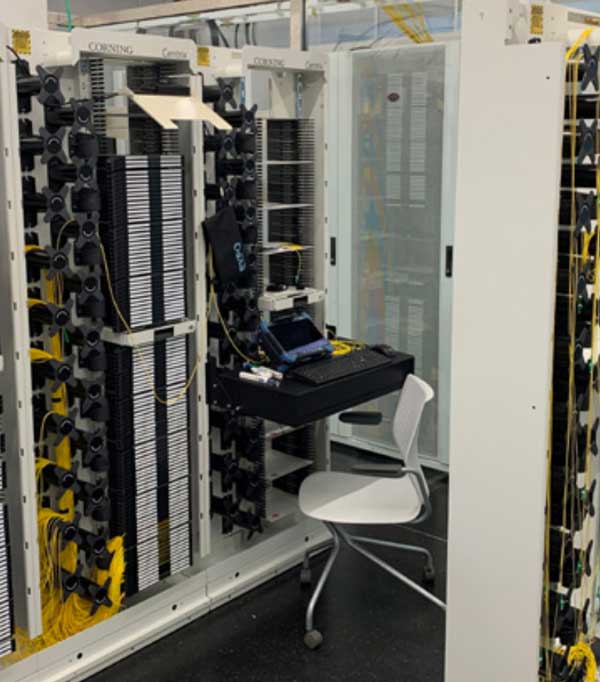
Service providers' equipment (including splitters for PON networks) are placed in the Netly Edge Fiber Center (headend)
Does a centralized fiber infrastructure make sense? Most networks today
are based on PONs, passive optical networks that use splitters to serve
multiple users from a single network GPON OLT port over one fiber, with
splitters placed along the network route. But will that architecture
still work in a decade or two? Possible, as 10G is already here and 100G
PONs using coherent transmission in R&D. And, then again, maybe
not. In the future we may need direct connection to every user.
The centralized fiber network Netly uses is really cheap insurance for
the future. If you are using GPON on Netly's cable plant today, you put
your OLT in their head end along with the PON splitters and connect to
every user on their dedicated fiber. If the architecture changes to
direct connection to the user in the future, a simple change of
equipment is all that is needed.
Is centralized fiber affordable today? Netly thinks so. But they are utilizing state-of-the-art products and technologies.
Based on his analysis of the market and new developments in technology,
Jack developed a unique business plan for Netly. The notion of
centralized fiber with a connection to every user makes sense today
because fiber is inexpensive and this architecture reduces the need for
numerous fiber distribution hubs and pedestals for splitters or other
equipment scattered around the service areas. And centralized fiber
architecture is ready for terabit applications.
For the cities on the Southern California coast Netly was interested in,
all were somewhat urban but mostly suburban in geography. Underground
installation would be required in areas where aerial cables were not
permitted, so using microtrenching made sense for the installation
method. Working with Corning, Netly chose a microcable that could be
blown into microducts. Each trench route has a microduct with six ducts
in a row. When only one duct was used, 288 fibers in the microcable were
available, but each route could be expanded to 6 of the 288 fiber
microcables for 1728 fibers total.
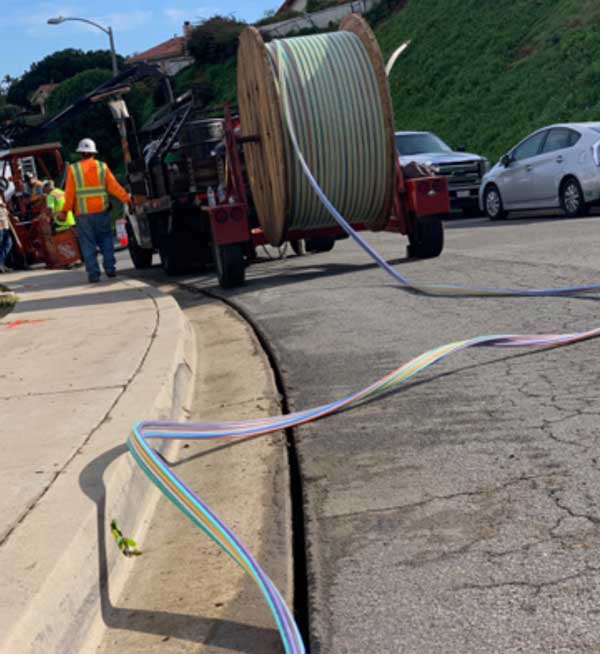
Netly microtrenches then installs 6 microducts.
Netly's microtrenching technique deserves a mention also. Where
possible, that is there are no conflicts with other buried utilities,
they trench at
the joint between the road pavement and the curb, minimizing damage to
either. Drops are done in small handholes near the curb, leaving an
installation that is almost undetectable. And installation is quick,
making for minimal disruption in a neighborhood.
Besides a unique model for the FTTH cable plant, Netly has used a
different model for their financing. Netly is funded by private
investors who believe this is the best model for FTTH networks and
offers the greatest potential for future growth.
The next Netly city will be Folsom, CA.
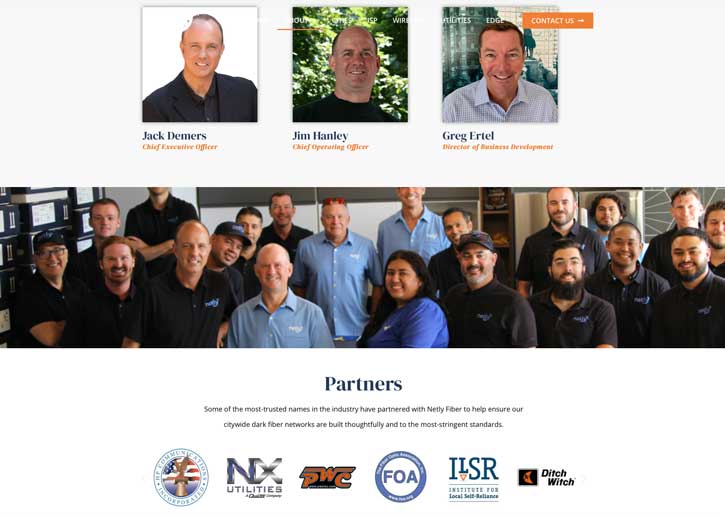
Netly founder Jack Demers and the staff. Note the FOA logo - we're a Partner.
Interesting Reading:
The NTIA Notice of Funding Opportunity (NOFO) - Only Certified Techs Allowed
Last month in the FOA Newsletter
we reported on the "NTIA NOFO" and how it basically says that broadband
networks it funds must be based on fiber optics. The document also
talks a lot about the workforce that is required to install this fiber
optics and the funding available to pay for training. For example, from
Page 57:
An effective plan for compliance with federal
labor and employment laws can include a subgrantee’s binding commitment
to strong labor standards and protections for the project workforce
(including contractors and subcontractors), which include:
Use of an appropriately credentialed workforce (i.e., satisfying requirements for
appropriate and relevant pre-existing occupational training, certification, and licensure);
The NTIA NOLO also states (page 24):
Eligible Entities that receive Initial Planning
Funds may use those funds for the following planning and pre-deployment
activities:
Training for employees of the broadband program or office of the Eligible Entity or
employees of political subdivisions of the Eligible Entity, and related staffing capacity or
consulting or contracted support to effectuate the goals of the BEAD Program;
and (page 33) a very important topic:
In drafting its Initial Proposal, an Eligible Entity should keep in mind that it may allocate grant funds for the following:
Training and workforce development;
What Does This Mean?
Each state's broadband office and every contractor
interested in working on these programs needs to think about the
workforce they will use. This US program will require many more fiber optic
techs than are currently available and those who are currently available
will need to confirm their credentials. Getting more qualified techs in
a job market where there are currently two openings for every person
looking for a job is not going to be easy.
The states can create their own training programs to help develop the workforce for their
projects at the state technical and community
colleges -
or even high schools - with the help of the FOA as did KY and OH.
States like KY recruited workers needed retraining - even laid
off coal miners became fiber techs. Now is the time to begin work on
setting up courses and recruiting candidates.
Like the actual projects, the money available for training will attract a
lot of "trainers" of various quality, and we already see some preparing
to sell their programs and even create new certifications. But only FOA
already has the proven experience, hundreds of schools, dozens of
programs and certifications recognized worldwide to create the
programs needed. (See the number of FOA certified techs to the left.)
The best evidence of the FOA work helping developing broadband
projects is the results in Kentucky where FOA helped organize the
workforce development program 6 years ago that has provided trained
fiber techs for building of Kentucky Wired. See the article below on how successful Kentucky Wired has been.
Fiber Optic History - The Movie
FOA recently created a timeline of fiber optic history
to show how the technology and applications of fiber optics has
developed in its 50+ year history. That seemed to be a perfect topic for
one of the FOA video lectures, so we created Lecture 73 in the FOA
series of lectures on fiber optics. This history of fiber optics is
narrated by FO President Jim Hayes whose voice you probably recognize
from other FOA lectures. Jim is a good choice as narrator because his
involvement in fiber optics starts in 1977/78, about the time of the
first field trials in the US and UK and includes the founding of the FOA
out of the original Fiber U training conferences.
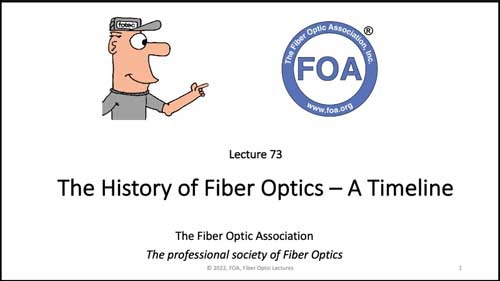
In addition, Jim was active himself in the early
history of fiber optics, starting one of the first fiber optic test
equipment companies and helping write the first standards for fiber
optics. So besides the general history, Jim adds a few stories of his
own work in the field and has some interesting tales to tell.
FOA Lecture 73, The History of Fiber Optics - A Timeline video is available on YouTube.
Who Can Use Fiber U? Everyone Does Use Fiber U
In last month's FOA Newsletter, we ran an article
talking about how everyone can use the free online learning courses at
Fiber U. This month, as we close out the books on the FOA's financial
year, we noted a startling statistic - the number of people taking
courses and then getting their Fiber U Certificate of Completion TRIPLED
in one year! We were astounded. But in today's world, lots of people
are taking online courses, and Fiber U with it's 2 dozen great courses -
all free - is what people want and need.
See for yourself: 2 dozen free online courses at Fiber U.
Cross Reference To FOA Technical Reference Materials
The FOA has created what is probably the world's
largest knowledge base on fiber optics. FOA has printed textbooks,
online technical information in the FOA Guide, more than one hundred
videos and has free online learning at Fiber U. Generally for a given
topic, like basic fiber optics, FOA will have the material printed in
book form, online as technical web pages, covered in several videos and
will use those to create a Fiber U course. With 11 textbooks in 4
languages, almost 1,000 pages of technical information on the FOA Guide,
100+ videos and two dozen online courses at Fiber U, all this can make
it difficult to find the right information.
Cross Reference To FOA Tech Materials
To help this, we have created a cross reference guide to the textbooks,
Online Guide and Fiber U courses, all the FOA technical information.
Besides the textbooks, online Guide and Fiber U, each section of the
Guide also includes links to the 100+ FOA videos available.
Cross Reference Guide to Textbooks, Online Guide and Fiber U
FOA Videos
We have also rearranged the 100+ FOA videos in similar categories on the
Contents Page of the Online Guide, making the videos, especially the
lectures, much it much easier to find a video on a particular
topic.
FOA Videos Guide.
FOA Newsletter
Sections
News
Technical
Worth
Reading Q&A
Training/FiberU
Resoures
Safety About
|
News
Lots more news
in Worth Reading below
|
Governor Announces Broadband Expansion Funding For Kentucky
Required reading for every state's broadband program managers.
In 2016, when FOA first traveled to Kentucky to host a statewide meeting
on fiber optic workforce development to support the new "Kentucky
Wired" program, Kentucky had the lowest Broadband availability in the
US. Recognizing this problem, the state authorized spending
$360million to build a backbone network to connect all 95 counties in
the state, then rely on local public/private partnerships to build out
connectivity to everyone.
FOA hosted this meeting because we knew that local techs to build the
network were going to be scarce. FOA only had a handful of CFOTs in the
state of Kentucky at the time, but we had a school in the Kentucky
Community and Technical College system, Gateway, that had been an FOA
school for years.
That started a very successful program that now has programs at 9 KCTCS
schools and has supplied many of the techs who worked for contractors
like Team Fischel and Ledcor to build the Kentucky Wired backbone. Many
of those workers were retrained workers from disappearing jobs like coal
mining as well as young people looking for well-paying technical jobs
with future potential.

FOA's Kentucky Wired Summit in 2016
The story of that historic meeting in Lexington, Kentucky should
be required reading for every state's broadband program managers.
Workforce development will be a problem as US government funding
begins, but Kentucky shows how the problem can be solved, with FOA help.
The issues FOA. the state officials, KCTCS officials and
representatives of the contractors brought up then are the same issues
we face today.
The Report On the 2016 Kentucky Wired meeting is here.
The news is that Kentucky Wired has successfully connected all the
counties and local build-out has begun. Partnerships, even with
AT&T, are being made to built FTTH networks around the state. In
June, Governor Andy Beshear announced that the state awarded 46 new
grants totally an additional $89 million to build networks in 35 more
Kentucky counties to connect 34,000 families and businesses. That brings
the total value of local grants to $203 million.
Details of the Kentucky Fiber Optic Build-out Grant Program. (Vendors take note, it lists all the recipients in detail.)
Not only have the 9 KCTCS schools thrived in their fiber optic programs,
Team Fischel has also become a FOA school using the FOA training
programs with their own employees everywhere.
Peabody High School Certifies First CFOT
We've written before about Dale Larocque's Peabody, MA High School FOA CFOT program. They just graduated their first student from the program, certified as a FOA CFOT, Vedant Patel.

We asked Vedant to tell us a bit about himself. "I really enjoy learning
how things work from inside, learning how computers are able to do math
of millions of numbers in just milliseconds, I also enjoy building
things up from scratch, gathering different materials to assemble them
all into one big product. As soon as I walked into Mr.Larocque’s
classroom the first time, I immediately knew this was the class for me.
Also big thank you to Mr.Larocque for putting so much faith and trust in
me, would not have gotten this far without his support."
Congratulations, Vedant, and kudos to Mr. Larocque.
FOA encourages more High Schools to consider fiber optic training
programs. Today, we need more trained technicians, not just for fiber
optics, but also the electrical and IT fields.
IMSA Convention Hosts IMSA/FOA CFOT Certification Training, Fiber Optic Sessions
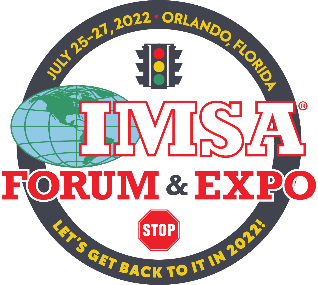
FOA is the fiber optic certification partner of IMSA, the International Municipal Signalling Association. The IMSA convention for 2022
will be held in Orlando on July 24-27 and offers an IMSA/FOA CFOT
certification course as well as several other seminars on fiber optics. FOA has been working with IMSA for several years
and we have learned that these are serious fiber techs. Many work for
cities as installers and inspectors where they must be familiar with all
aspects of fiber optics.
The CFOT class this year will be taught by Sam Garman, VP of Atlantic
Transportation Systems, Inc.in Camp Hill, PA and officer of the IMSA New
Jersey Section. Sam was trained and certified as a FOA CFOS/I
Instructor by Tom Collins of Techtricians, FOA Master Instructor who has
been conducting IMSA/FOA CFOT certification classes. (See below for
another of Tom's courses.)
FOA will be at the IMSA conference trade show in Booth 125, represented by Stacey Mueller, Program Director at About Phase Academy - offering training in the transportation infrastructure industry including FOA certification courses as well as the IMSA/FOA CFOT certification classes. It you are at the IMSA show, stop by and visit with Stacey.
Training For "Warriors For Wireless" Uses New Training Tool
Tom Collins, FOA Master Instructor, does a lot of
training and likes to try new tools to make training better. He's been
using WiFi connected instruments like the OTDR to allow students to
operate the OTDR from their mobile devices. In a recent course for the Warriors For Wireless organization, Tom introduced a new tool, a fiber optic network simulator from M2 Optics in Raleigh, NC that had been donated to Warriors for Wireless.
Tom's report, "Our recent Warriors 4 Wireless fiber optic class used a new training aid, the M2 Optics Inc. Fiber Lab MSP trainer with
our OTDR. The trainer has one event that contains a splitter with a PON
system. The unit is a hard case with multiple runs of fiber with
splices. It’s portable but sturdy enough for the road. We utilized the
trainer in all three of our courses, the CFOT, CFOS/Testing, and
CFOS/Wireless. Students seemed to like it and it can be incorporated
into all of our lab modules. Student tested and instructor approved!"
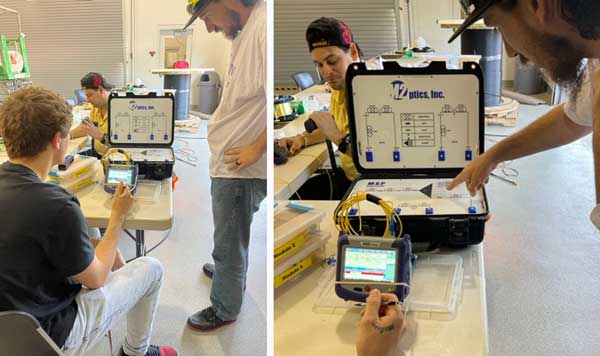
Designed specifically for OTDR training and demonstrations, M2 Optics
customizes the Fiber Lab MSP to each user’s specific requirements.
Offering a wide range of fiber types, lengths, and events, the
integrated MSP unit brings the field network experience into the
classroom. Go to the M2 Optics website to learn more. Special discounts are available for FOA training schools.
Warriors 4 Wireless
is a charitable organization existing solely to help veterans find
decent paying careers in the growing 5G wireless workforce. They have
invested well over $3,000,000 of contributed funds to assist veterans
joining the telecom workforce and have connected over 3,100 veterans to
telecom career opportunities. Let them help you!
For more information, contact Tom Collins at  https://thetechtricians.com https://thetechtricians.com
Beaver Causes Power And Internet Outages In Northwestern B.C., Canada

A beaver was the cause of a June 7 outage which left many residents of
northwestern B.C. without internet, landline and cellular service for
more than eight hours. The beaver gnawed its way through a tree which
then fell on both BC Hydro lines and a Telus fibre-optic cable line
strung along BC Hydro poles between Topley and Houston.
The resulting power outage affected only 21 customers but the fibre
optics damage affected Telus customers in Burns Lake, Granisle, Haida
Gwaii, the Hazeltons, Kitimat, Prince George, Prince Rupert, Smithers,
Terrace, Thornhill, Houston, Topley, Telkwa, Fraser Lake and
Vanderhoof. CityWest, the utilities company owned by the City of
Prince Rupert, also had its customers affected because it uses the Telus
fibre optics line.
BC Hydro official Bob Gammer said crews identified a beaver as the
culprit because of chew marks at the bottom of the downed tree. The
lines are located in a swampy area and with the high water levels, there
was some difficulty accessing the site, he added. “It's unusual, but it
does happen every once in a while,” Gammer said.
Read more at CTV News, Vancouver, B.C., Canada
|
Technical
On fiber optic
technology, standards, equipment, installation,
etc.
The FOA
Update Page covers all the new technology
and applications we covered in this newsletter
recently. Now you can review all that new tech at
once.

Want to know more about fiber optics? Study
for FOA certifications? Free
Self-Study Programs are on "Fiber
U®." Looking for specific information?
Here's the largest technical reference on the web:
The
FOA Online Fiber Optic Reference Guide.
|
 Eliminate Added Costs By Switching
To Splice-On Connectors Eliminate Added Costs By Switching
To Splice-On Connectors
To optimize your
fiber optic network, splice-on connectors (SOCs) are a great place to
begin. Check out our latest blog update for a detailed comparison
between SOCs vs. other
field-installable connectors.
Read more in the Sumitomo BLOG.
|
(Every month, FOA gets dozens of technical
questions and the most interesting ones end up in the Good Question
section below. These two, however caught our eye and deserve featuring
in our Technical section.)
Managing And Maintaining a Fiber Optic Cable Plant During Its Lifetime.
Q: Are there guides / recommendations for optic fibre cable
life cycle management? (outside plant) including rehabilitation /
replacement timelines together with factors that may alter those
timelines ( such as seismic activity, extreme weather, human
activity-induced fibre cuts etc) also including typical performance
deterioration over the life cycle, and the performance levels at which
replacement / rehabilitation happens. Or does it happen (and is it
normally expected) that operators replace entire sections of fibre (say
400 km) as part of routine maintenance?
A: There is a saying here in the US that in fiber optics “the most common cause of failure is “backhoe fade” in underground cables
and “target practice” for aerial cables.” In other words, damage
caused by humans. We know of many fiber optic cable plants that have
survived natural disasters like earthquakes - in fact there is a lot of
work today using regular cables used in communications to monitor for
seismic activity. Fire can be a problem in remote areas, but often it’s
because the poles are burned causing the cables to fall.
Over the years we have questioned cable manufacturers about the lifetime
of fiber optic cable. They don’t like to make definitive statements but
we have been told that based on the cables installed in the past that
40 years is a probable lifetime for most cables. There are certainly
cables in use today that are over 30 years old already. The glass fiber
is not a problem, it’s the protection from the cables that will
eventually fail. Installation techniques can have an effect on the
longevity. For example splice closures should be sealed properly to
prevent ingress of moisture or dirt. Cables should not be installed with
bends below the rated bend radius or with excess tension.
FOA has always told users that fiber optic cables do not need maintenance (https://foa.org/tech/ref/user/maintain.html),
a response to some people advocating periodic inspection and cleaning
of connections, for example. That’s just more likely to cause damage.
When an accidental break in a cable occurs, we have guidelines for restoration (https://foa.org/tech/ref/restoration/rest.html), and planning for restoration when building the cable plant is very important.
Someday you will certainly want to replace cables, often well before the
lifetime of the cable, but generally because you need more fiber or the
older fiber will not support the network speeds you want for upgrades.
Planning for more fiber by installing more cables can be eased by
installing spare underground ducts when first installing cables - here
in the US, we call this “Dig Once” (https://foa.org/tech/ref/OSP_Construction/Underground_Construction.html). Testing fibers for higher speeds is called "fiber Characterization” (https://foa.org/tech/ref/testing/test/CD_PMD.html) and is routinely done when speeds above 10G or certainly 100G are considered for older fibers.
Knowing that the lifetime of fiber optic cable plants are ~40
years, it makes sense to plan ahead for future applications, installing
lots of fibers, leaving lots of open duct space and choosing network
architectures that will not obstruct upgrades. See the article on
Netly's network above.
Interpreting Customer Spec For Cable Plant Loss
Q: I am currently being challenged by my
customer on some testing parameters and was wondering if I can
receive your input regarding the EIA/TIA-598B standard.
A: The customer spec: l. Rated attenuation: 0.35dB/km and 0.25dB/km at 1310nm and 1550nm, respectively
As we read the customer spec, this section “L” below refers to the
cabled fiber attenuation coefficient of the cable as supplied to the
contractor, not the installed fiber after splicing and termination.
Thses are typical specifications for today’s high quality fiber. It is
also slightly lower than specifications noted in most standards today,
e.g. 0.4 dB/km at 1310 nm is more common. See https://foa.org/tech/ref/basic/fiber.html in the table at the bottom of the page, noting OS!/G.652 fiber specs.
After installation, splicing and termination, the total loss of a fiber
link includes the losses from splicing and termination, plus any passive
devices like PON splitters that may be installed in the link. When
calculating the loss budget (https://foa.org/tech/lossbudg.htm) to
compare to actual test test results, splices may be calculated at
0.15-0.3 dB each and connectors at 0.3-0.75 dB each, adding to the end
to end loss and affecting the calculation of dB/km.
For example, 10km fiber with 4 splices and two connections (the ends) would have a total loss of:
Fiber: 10 km @ 0.35 dB/km = 3.5 dB
Splices: 4 @ 0.15 dB each = 0.6 dB
Connections: 2 @ 0.3 dB each = 0.6 dB
Total link loss = 4.7 dB
If you calculate dB/km for the installed link, it becomes 0.47 dB/km,
even though we used the lowest loss specs for splices and connections.
As stated above, the spec you called out refers to the cabled fiber only
and should be verified by the test documentation supplied by the
manufacturer on the reel.
The loss of the installed link should be calculated in the loss budget
for the link as designed using the given fiber spec plus reasonable
specs for splice and connection loss.
Testing should be done with a light source and power meter (OLTS) and a second test with an OTDR per OFSPT-7 or FOA Standard FOA-1 (OLTS) and FOA Standard FOA-4 (OTDR).
Mobile App Collects Test Data And Stores In The Cloud
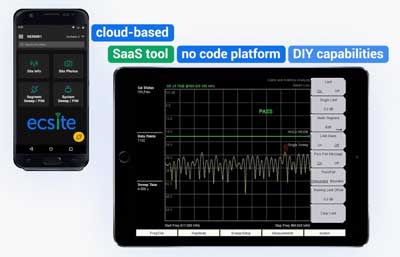
ECSite is an app for mobile devices that captures and stores data online
for making reports, making reports faster and easier. The app maker
already has setups for EXFO, Fluke, Anritsu and AFL OTDRs already,
simplifying use. Watch the video or go to the ECSite website for more information.
OFS Develops New Aerial Cable Management System
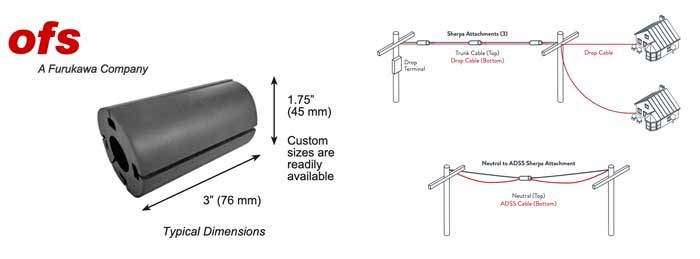
OFS has introduced an interesting option for installing aerial cable.
It's a molded rubber gadget that snaps onto an existing aerial cable to
allow installing other cables. One version snaps onto ADSS cables to
allow running smaller square or round cables like drop cables for FTTH.
Another version is for neutral power cables or metallic messengers to
allow simple installation of ADSS cables. It might be a easy way to add
cables to an existing aerial span.
See more about the OFS Sherpa cable management system here.
The Right Way To Mount A Splice Closure And Store Service Loops On A Pole
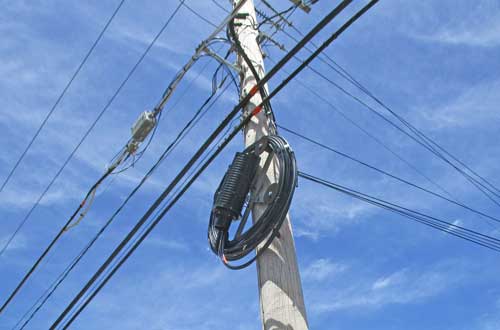
Notice the bracket bolted to the pole, neat service loops and secure mounting of the splice closure.
(Photo by Milt Murry taken in Rolla, MO.)
Without Comment:
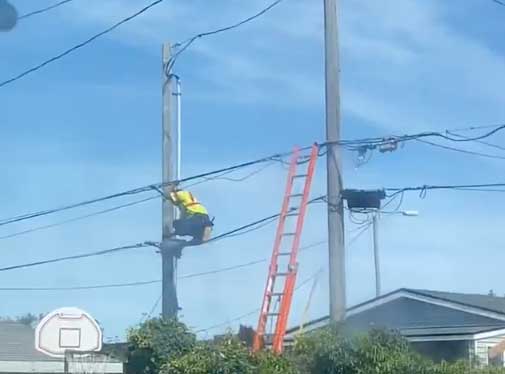
See the video for yourself (LinkedIn posting)
And The Perils Faced By Aerial Cables
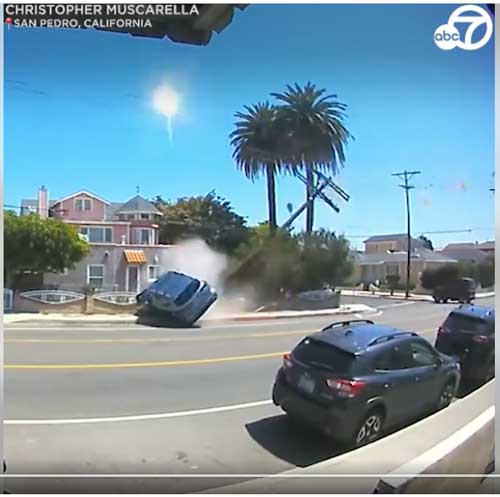
Watch the video of the crash from a doorbell camera in San Pedro, CA.
Warning For Techs Doing OSP Restoration
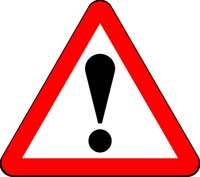
FOA recently received an inquiry that was a new one; whether techs
working on restoring OSP links should be concerned about eye safety if
the link used fiber amplifiers. To answer this question, we had to do some research on fiber amplifiers.
The short answer is YES, you should be concerned. The long answer is
more technical and includes details that every OSP tech needs to know.
See "Fiber Amps And Restoration" in the FOA Newsletter Archives..
Try The FOA's Online
Loss Budget Calculator
FOA
has written many articles about loss budgets,
something everyone involved in fiber optics needs to
know and needs to know how to calculate. We've
created a online Loss Budget Calculator that does
the work for you. Just input your cable plant data
and it calculates the loss budget. It works on any
device, especially smartphones and tablets for field
use and even allows printing the results.
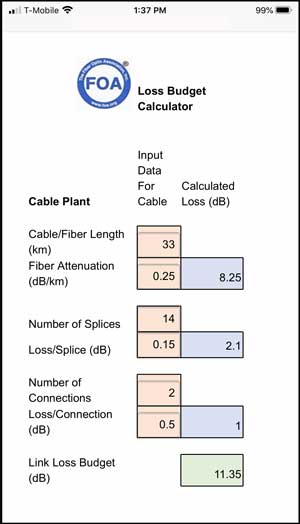
Bookmark
this page (especially on your smartphone): FOA Loss Budget Calculator
Online
|
Worth Reading
Each month we read
hundreds of newsletters and online articles. These
are the ones we think you will find "worth
reading."
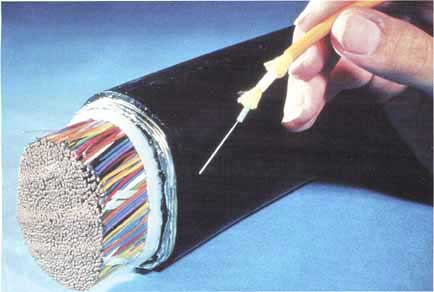 AT&T PR photo from the mid 1970s AT&T PR photo from the mid 1970s
The FOA's History
|
Worth Reading (And
Watching):
July 2022
Vermont not waiting for federal BEAD grants, funding broadband development now. ILSR.
Four Wind Farms Constructed at once. T&D World. Wind power needs lots of fiber optics - OPGW.
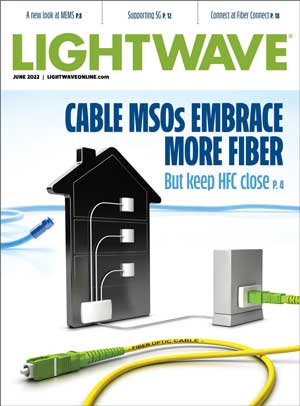
Lightwave's Summer Issue focuses on fiber in the CATV industry and more.
Multilink’s SpeedFlex Push Fiber Up to 12 fibers in a cable you push into conduit or staple to a wall.
Reports of the Pay Phone’s Death Are Greatly Exaggerated - The New Yorker
Worth Watching: Conocimiento Esencial: ¿Por qué la fibra óptica? creado por FiberWizards
June 2022
Recruiting And Training Today's Fiber Optic Workforce - Learn the fundamentals to recruit and train new fiber optics - by FOA's Jim Hayes in ISE Magazine.
Explosive Fiber Broadband Expansion Drives Need for Fiber Technician Training Programs
- Telecompetitor - As fiber sees record-setting deployment levels, the
demand for fiber optic technicians is stronger than ever.
NTIA Notice of Funding Opportunity Information from the funding source on applying for US broadband funding
2023 National Electrical Code® - Revisions to Cable Requirements from CCCA. Requirements for some fiber optic cables are moved from Article 770 to new Article 727.
May 2022
Google Video On Their Undersea Cables YouTube Slick but interesting video on how undersea cables are designed, built and used.
2022 Submarine Cable Map depicts 486 cable systems and 1,306 landings that are currently active or under construction. Telegeography.
RTI Telecom Magazine from Brazil, in Portuguese. A revista RTI do mês de abril já está disponível online e recomendo a leitura de alguns artigos:
April 2022
CENIC Technology Roundtables
- Videos of past webcasts on wIreless and CATV broadband with fiber
coming soon. Some of the best reviews of state of the art technology
from California's state of the art R&D and education network.
Construction Without Disruption - FOA President Jim Hayes' column in ISE Magazine
State of California Middle-Mile Broadband Initiative - California ALL program
March 2022
Every State Has a Chance to Deliver a “Fiber for All” Broadband Future: Electronic Frontier Foundation
Pew Charitable Trusts has released a couple of new tools for state broadband offices preparing for the influx of federal funding. ILSR
PEW Charitable Trusts has a broadband initiative that aims to help local networks get started.
February 2022
Fiber Optics Installed By The Lowest Bidder - ISE Magazine - by Jim Hayes, FOA President.
Building Broadband During Component and Worker Shortages
- Broadband Communities - Completing broadband builds requires
competent fiber optic techs, but training them requires understanding
how they learn - by Jim Hayes, FOA President.
Worth Reading - Magazines, Websites and Newsletters
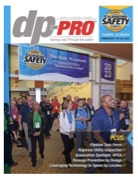
The latest Issue of
dP-PRO, the "call before you dig" magazine, is
online. It's the 2022 Special Locate issue.
dpPro sponsors the annual digging safety conference each year - next year in Tampa.

New Fiber Optic
Magazine In Spanish
Todo Fibra Optica is
a new digital magazine in Spanish for fiber optics
in Latin America. Jose Enriquez, editor of Todo
Fibra Optic magazine has many years
experience in the fiber optic industry so he knows
the industry well. FOA will be working with him to
share our extensive technical materials in Spanish.
Read their newsletter here.

All issues and subscriptions.
Contact:
José Manuel Enriquez Mora, Editor
Todo Fibra Optica LLC
https://todofibraoptica.com/revista-ediciones/
+52 222 302 8224
jose.enriquez@todofibraoptica.com
1995-2020
- FOA's 25th Anniversary!
As
part of celebrating 25 years of serving the fiber
optic industry as its primary source of technical
information and independent certifying body, FOA
thought it appropriate to create a short history of
the organization and how it has developed to
help the fiber optic industry. We also wanted to
recognize the contributions many people have made to
the organization over the years that made FOA what
it is today.
The FOA history is now archived on the FOA
website where you can read it anytime or link to
it. Updated
info - dB, total internal reflection and science
projects,
Worth Reading - News
Summary - Past Links Worth Repeating
1983
Video of AT&T's First Test Of A Submarine
Cable System From the AT&T Tech
Channel archives (worth exploring!)
Richard
Epworth's Optical Fiber History from his work
at STL from 1966 with Charles Kao.
Communications Systems Grounding
Rules: Article 800 provides specific
requirements by
Michael
Johnston, NECA Executive Director of
Standards and Safety in EC Magazine
US Broadband Coverage By Service
Provider from the FCC
How
To Build Rural Broadband, Learning From History
In the August 2021
FOA Newsletter, we published a lengthy article on
rural broadband and compared it to rural
electrification in America in the last century.
Much of the comparison was based on an article
written in 1940 by a USDA economist, Robert Beall,
called "Rural Electrification."
If
you are interested in or involved in rural
broadband, we recommend you read the article "How
To Build Rural Broadband, Learning From History"
in the August 2021 FOA Newsletter and
read the Beall article also.
Recycling Fiber Optic
Cable - Contact:
Steve Maginnis
LD4Recycle/ CommuniCom Recycling
(Visit
website)
sm@LD4Recycle.com
803.371.5436
Sumitomo's Ribbon
Splicing Guide - download from
one of the leaders in splicing.
"Who Lost Lucent?: The
Decline of America's Telecom Equipment Industry"
This is a MUST READ for managers in telecom or any
industry!
This long and
well-researched and annotated article in American
Affairs Journal should be mandatory reading
for every high level manager in a telecom company -
or any other company for that matter. To summarize
the article, today, America has no major telecom
equipment company and fears the major suppliers of
equipment who are all foreign, especially the Huawei
from China. This article explains how America got
into this deplorable state.
OFS also has an excellent
website and blog of tech articles worth browsing.
IEC 60050 - International
Electrotechnical Vocabulary - An
extensive dictionary for fiber optics in English and
French. Highly technical - this is one definition:
"mode - one solution of Maxwell's equations,
representing an electromagnetic field in a certain
space domain and belonging to a family of
independent solutions defined by specified boundary
conditions"
If you are interested in restoration -
aren't we all? - you should also read this
article in dpPro magazine by FOA President Jim
Hayes: Damage Protection Requies
Looking Overheas As Well As Underground
- dpPRO Magazine - about the problems with
aerial cables. His previous article for the
magazine was New Techniques for Fiber
Optic Installation.
How much fiber optic cable is
manufactured each year? CRU Reports -
unsurprisingly China is by far the largest market
today
The Institute for Local
Self-Reliance weekly newsletter has
lots of interesting articles and links.
The Open Technology Institute at New America just
published “The Cost of Connectivity 2020,”
US Ignite and Altman
Solon issued “Broadband Models for Unserved
and Underserved Communities”
Universal access to broadband
is a cornerstone to a strong economy,
Achieving universal access will require
community partnerships. by Alfreda
B. Norman, Sr. VP, Federal Reserve Bank of
Dallas
FIBER TO THE FARM: The
co-ops that electrified Depression-era farms are
now building rural internet. Be sure to check out
the high-tech equine installation equipment.
Next Century Cities Newsletter
- News from cities around the US
including Detroit and New York plus small
Infrastructure Get Some
Respect, NY TImes "On Tech"
"The magic of the internet requires a lot of
very boring stuff behind the scenes. "
DIRT
Report On Damage To Utilities Common Ground
Alliance (CGA) annual DIRT report provides a
summary and analysis of the events submitted into
CGA’s Damage Information Reporting Tool (DIRT) for
the year 2018. The complete report is available
for download here. In addition,
there is an interactive dashboard that
allows users to filter the data more by
factors contributing to damages.
Structured Cabling News
- a website and weekly newsletter about cabling.
The Internet Master
Plan for New York City.
The New York City Internet Master Plan is a
comprehensive framework for the infrastructure
and services that provide connectivity to New
York City residents and businesses. This
Master Plan will guide City actions and
public-private partnerships to transform New
Yorkers’ access to this essential
infrastructure for generations to come.
Fiber Trivia From
Corning.
The
Future Of Work Is Skills - So Stop Worrying
About Degrees - The
reality is the future of work is about skills, not
just degrees. (FOA Newsletter Feb 2020)
The job market is hot. So why
are half of U.S. grads missing out?
VIAVI Books On
Fiber Optic Testing (2 volumes) - They're back!
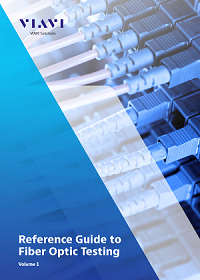 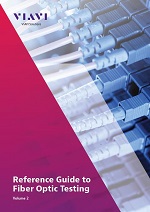
Besides
the FOA reference materials, two JDSU/VIAVI
textbooks, Reference Guide to Fiber Optic Testing,
Volumes 1 and 2, were used as references for
some of the FOA courses and are recommended for
instructors and students. The books are available
from VIAVI as eBooks and the everyone should
download them and recommend them to others.Download
yours now. Volume 1. Volume 2. Viavi Books
Ciena's Submarine Cable
Handbooks (4 to download)
Guidebook To MPO
Testing OptoTest
offers this complete guide to MTP®/MPO testing. In
this guide, you will learn all there is to know
about the different test methods, equipment
options, troubleshooting, and best maintenance
practices to ensure that you have the best testing
experience. Go here to download the book.
50th Anniversary of The
Development of Low Loss Fibers A history
of the development of low loss fiber, a fascinating
story by Jeff Hecht on the OSA (Optical Society of
America) website.
How OFS Makes Fiber
Interesting YouTube video on how fiber is made.
Perhaps a little too much "show biz" but
fascinating. If you have ever seen fiber
manufacture, look at this video. You will be amazed
at how big preforms have become!
How Nexans Makes Copper Cables
- compare the process to fiber - don't most of the
machines look similar?
The True Cost of Telco Damages
(what backhoe fade or target practice can
cost)
Rural Electric Cooperatives:
Pole Attachment Policies and Issues, June 2019.
Clearfield-FOA Certification
Training Clearfield is now offering
their customers an FOA
CERTIFICATION course. This course
provides a basic understanding of fiber optic
technology, as well as Clearfield product
knowledge and how Clearfield’s integrated product
systems work together in a fiber network.
Substandard Contractors - Fiber
Optic Knowledge Doesn't Always Trickle
Down (EC Mag)
Another Source Of
Articles On Fiber
FOA
President and editor of this newsletter Jim Hayes
has also been writing a column in Electrical
Contractor Magazine for almost 20 years now.
Electrical contractors do lots of fiber work and
this column has covered some topics they are
interested in including installation processes,
network design, fiber applications and a lengthy
series on dark fiber - what it is, how's its used
and how it benefits the growth of communication. A
recent web site redesign makes it easier to browse
all these articles - just go to http://www.ecmag.com/contributing-authors/jim-hayes
and you can see all of them. |
Q&A
When readers ask us questions, we genrally refer them to FOA
resources where they can find the answer to their question and many
more. We first send them to the FOA Guide
which is the table of contents for the FOA technical resources. There
they can find pages indexed by topic and a search engine for the FOA
website. It also links them to FOA videos and courses on our free online learning site Fiber U.
The FOA
Fiber FAQs Page (FAQs = frequently asked
questions) gathers up questions readers have
asked us (which first ran in this newsletter)
and adds tech topics of general interest.
|
Good Question!
Tech
Questions/Comments From FOA Newsletter Readers
July 2022
Also see the two important questions above in the Technical section.
Test Source Variations
Q: When we plug in the patch cable to use as a reference
to get ready for our insertion loss test, our power meter gives us
different readings each time we plug in and unplug the cable. Is
this normal?
A: If you plug a reference cable into a source, it is likely
to have some variation in coupling each time so the power out of the
cable is different. Once you plug the cable into the source and a
reference set with the meter, you should not remove the cable until you
finish testing.
Test Source Modulation Options
Q: Our light source user’s manual listed the following:
“In the actual project, it is necessary to load the audio carrier in the
optical signal to identify the optical fiber. The equipment contains
three carrier frequencies, which are 270Hz, 1KHZ, and 2KHz.” Can you
tell me if I need to be concerned about setting this to a certain value?
A: Sources often have an option to modulate the source for
use with another instrument called a “fiber identifier.” Then it offers
the output as DC or CW (a steady unvarying signal) or modulated at
270HZ,1 or 2 kHz. When testing loss the DC or CW setting should be used.
June 2022
Differences in OTDR Traces
Q: What causes the differences in otdr traces for fibre cores that are in the same cable?
A: Several things can cause the fibers in a cable to have differences in their OTDR traces:
Differences in fiber from different production batches including fiber that may come from different preforms.
Differences in stress on the fiber caused by inconsistent cable design and manufacture
Of course differences in splices including stress on fibers in a splice
closure and terminations including stress on fibers in racks and panels.
"Mining" Cables In Data Centers
Q: Is there any documentation out there on best practices for DC cable mining? Any help would be greatly appreciated.
A: This has been a topic in premises cabling since first
proposed by NFPA for the NEC twenty years ago. FOA has gotten this
kind of question before for many different circumstances, but I must
admit that I know of no recommended procedures or standards for the
removal of abandoned cable.
Cable “mining” often refers to the removal of
underfloor cable, may apply to cables in trays and is hard to get
information online - search for “Cable mining” and you get links to
sellers of cables designed to be installed in mines (coal, salt,
minerals, etc.) underground!
The biggest problem with removing unused cables is
identifying the cables to remove. Underlloor cables are particularly
bad, it seems, since you have generations of abandoned cables, often
poorly marked, sometimes mixed with power cables. With metallic cables,
you can sometimes use an ancient telephone tool, a “toner” to trace
cables, With fiber you just have to be careful that you identify the
cable before you cut.
It’s always better to remove small sections, especially if you can tug
on the cable and verify it each time before cutting. We’ve seen photos
of an early data center with cable trays 2 feet deep by 4 feet wide full
of about 4,000 fiber optic cables. After seeing that you understand why
the new high fiber count cables (1728, 34456 and 6912 fibers) are
desirable!
Calibration of Fiber Optic Power Meters
Q: Why does this tester sold so cheap show the same value for 1310 and 1550?
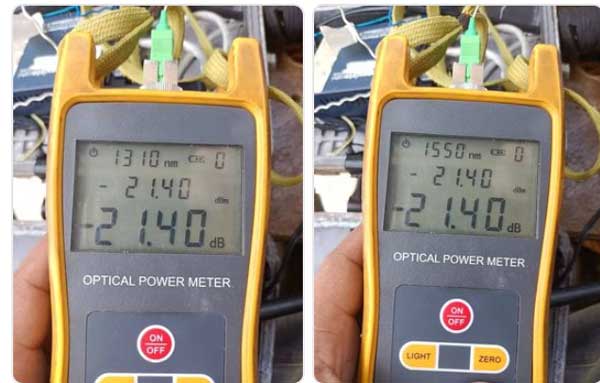
A: We’ve purchased and tested several
of these inexpensive meters based on questions from our instructors and
readers. They have a similar “feature” - they are not calibrated to
international standards of optical power, so when you measure dBm, the
result at any wavelength may vary considerably from a meter by a major
manufacturer who does calibrate properly.
However, these meters have a menu item that allows you to calibrate them
yourself. We've calibrated all the ones we tested to match our
calibrated instruments and after that they work OK.
Interestingly, they show loss as negative dB, which is how we think it
should be. Some large, famous manufacturers manipulated the standards to
make loss a positive number, so if you measure gain, it is considered a
fault.
May 2022
Designations For Fibers
Q: I'm currently working on a project involving optical fiber
with VMS signs, CCTV cameras and other ITS equipment. I was wondering if
there is a standard or a good practice which describe the typical
assignation for each optical fiber on a 6 fibers cable for
example? By that, I mean :
- fibers number 1 and 2 : VMS;
- fibers number 3 and 4 : CCTV;
- fibers number 5 and 6 : spares
A: There are several ways people assign polarity on duplex links.
The way you suggest is the most common I believe. Use the odd number
fibers to transmit in one direction, even number fibers to transmit in
the other direction and document the color codes.
Storing Fiber Optic Cable On Reels
Q: is there a "standard" for how to store a fiber optic cable reel?
A: This is another detail that has not in my knowledge ever been
included in a standard. However manufacturers usually put a note on the
reel to keep it upright - standing on the edges of the spool sides, not
flat on one side of the spool. If the fiber is to be stored for a
period of time, it should be stored in a cool dry place and the ends
sealed with electrical tape.
(Photo storing cable on reel)
Optical Power Of FTTH Signals
Q: I wanted to know on a fiber to home what is the optimal signal
strength I should receve at? I have a leg that is 21 km long I
receive at 1490 at -22 dBm is that to low, everything looks good on my
traces
A: The specifications for GPON are here. https://foa.org/tech/ref/appln/FTTH-PON.html
The standard for GPON calls for receiver power at -13dBm max to -28dBm minimum, so -22 dBm is OK.
April 2022
850 LED Test Source
Q: I need to test multimode fiber at 850 nm but sources are hard to find and expensive. Can I use a laser?
A: Multimode
fibers should be tested with an LED. Lasers have several problems in
multimode fiber that may cause untrustworthy readings. The problem is
that LEDs are no longer used for transmission systems; every MM system
now uses VCSEL transmitters, a surface emitting laser. As a result most
LEDs at 850nm for MM have gone out of production. Two engineers I know
who have been looking for them say there is now only a few sources and
the price is much higher that of a few years ago. We've been buying used
test sources on eBay for training.
105 Micron Fiber?
Q: I have a customer asking about 105um fiber. Does it exist? What is it basically used for? After FOA suggested a clarifying question to the customer: The
fiber is for Power over Fiber(PoF). The construction is 105um fiber
with 125um cladding. The question or assumption would be – The
termination would be the same as 50,62.5 or 8.3um with a 125um cladding?
A: The people who do laser surgery and power over fiber
use special step index fibers and SMA connectors. The power density can
be very high so the heat can build up in the cable. SMA connectors or
the metal ferrule swaged-on connectors are often used for their
all-metal construction with the ability to withstand heat and sometimes
the need to be drilled for special fiber diameters. Because of the high
power, the polish needs to be low reflectance, so we’d recommend using a
wet polish and end with a very fine polishing film - 0.3 microns or so.
Like polishing SM for DWDM.
Cleanliness is very important for these applications. I remember a call
from a doctor doing laser surgery who kept ruining cables because they
were dirty and the high power literally exploded the dirt and pitted the
ends. When that happens, sometimes they can be polished out but often
they are ruined. The same thing happened to the 120 inch telescope at
Lick Observatory when Joe Wampler tried using it to laser range to the
retroreflector Apollo 11 left on the moon. Exploding dust pitted the
aluminization on the mirror.
Gel Leaking From cables
Q: We have several instances where gel from inside
the fiber optic cable has leaked into the splice closure. I have seen
some information about sealing the ends of cables so that this doesn’t
happen but cannot find a specific method or procedure for this or what
to use for a sealant. Is this something that is common practice for
outside plant cables? The gel creates a mess and definitely makes
reentry for additional splicing more difficult. If there is a way to
prevent or minimize this I would like our technicians to start
implementing it.
A: When you install the cable, after inserting the cable
in the splice closure and/or the budder tubes in the splice trays, seal
the end with silicone RTV adhesive. It needs some time to cure but that
should prevent the gel leakage. Or next time, order dry water blocked
cable which will not have this problem.
Single Fiber DWDM
Q: Can you do bidirectional links on a single fiber with DWDM? (Dense Wavelength Division Multiplexing)?
A: A company Called Edge Optical Solutions sells
multiplexers for bi-directional DWDM on one fiber by using
adjacent wavelength channels for each direction. It is good to ~400km
with coherent transceivers but cannot use fiber amplifiers for
repeaters.
March 2022
Maximum Fusion Splice Loss
Q: We have set 0.4 dB as our max for all losses per splice
and my counterparts argue that customer quality will not suffer with a
1.0db-1.5db loss at a splice. What do you think?
A: We would argue that the issue with high loss splices is more
one of reliability. Most fusion splices of singlemode fiber are 0.05 to
0.1 dB A splice that has more than ~0.2dB loss probably has some
inclusion (dirt that got on the fiber after cleaving) or an air bubble
with means the splice is deficient in strength and may fail over time.
If the network is operating at high power with WDM and fiber amplifiers,
the inclusions or bubbles may produce heat which can cause failures. At
very high speeds or using coherent communications over long lengths, it
might affect dispersion.
Another Way Of Expressing dB?
Q: Just wondering what to
think about presenting dBm as a percentage of power, using either a
linear measurement or quadratic equation ?
I recently came across this article : [https://lnkd.in/eYkfpHzD] I
realise it's Wi-Fi signals here, but can you compare this to anything
concerning optical loss or gain , given we're still using dB and dBm ?
A: I had to read this 3 or 4 times to get the idea. Basically
he suggests converting dB, a nonlinear log scale, to a linear scale
expressed in %. Following his steps (assuming I understand his system) ,
100% = 0 dBm (1mw), 90% = -10dBm = 1/10mw = 10% of the original
signal, 80% = -20 dBm = 1/100 mW = 1% of the original signal.. So 80% =
1% of the original signal. And that’s where it seems a bit nonsensical.
70% would be 0.1% of the original signal,,,
We fail to see what this “new math” accomplishes.
OTDR AutoTest
Q: Would we say that OTDR 'Smart' test capabilities are commonplace on newer models or only on some manufacturers meters ?
Maybe it's additional software that can be thought of as an upgrade ?
A: Some form of “auto test” has been available on most OTDRs
for 20 years or more. Early versions were not very good; they usually
just made a test under some average test conditions and reported the
results. Modern OTDRs use more powerful computing power to make several
tests and determine which conditions are best for the fiber being
tested. By optimizing the range, pulse width, number of averages, etc.
it can usually produce fairly good results. We don’t think the cost of
the OTDR is an issue for new ones because users expect all of them to
have a good auto test function. As to whether an older unit could be
upgraded, that would depend on the manufacturer and if they still
support that product. An OTDR less than 5 years old should probably be
able to be upgraded.
February 2022
MM Splice-on Connector On Singlemode Cable
Q: I encountered a situation where a MM
mechanical connector was used on a SM fiber and passed on an OTDR test.
The client and I are interested in understanding how these connectors
could have passed?
A: The joint between a multimode and
singlemode fiber should have vrey high loss, ~17-20 dB, depending on the
mode fill of the MM fiber. However the short length of the MM fiber,
~10mm, might not be enough to cause the modes to fill in the short fiber
in the connector, resulting in relatively low loss.
Eric Pearson, one of the most knowledgeable people on connectors
expressed this idea then tested it with 100m singlemode connected to a
second singlemode cable. The second singlemode cable has an OM3 LC
unicam connector, An EXFO ftb-400 OTDR indicates a 2.09 dB drop. That is
way too much to pass a test but nowhere near the loss that could be
expected from the MM/SM joint. See the OTDR trace above.
November/December 2021
Fiber Optic Color Codes Reference Chart
Q: Has anyone made a fiber optic pocket reference chart that has cable
color orders, frequencies, or other commonly used info on it?
A: The FOA has a page on its Online Guide that covers color codes
(https://foa.org/tech/ColCodes.htm). It is the most popular page in the
FOA Guide! It works great with a smartphone.
Underground Utilities Location
Q: From an OSP engineer: Is there a resource for
underground utilities that we could use on our engineering designs? I
know some counties offer this info but is there a single resource for
all?
A: If you are in the US, the Common Ground Alliance (https://commongroundalliance.com , https://commongroundalliance.com/Tools-Resources/Resources-Library/Toolkits)
is a resource for designers and contractors looking for information on
underground utilities. Their “CGA Best Practices”
(https://bestpractices.commongroundalliance.com) is the best reference
for damage prevention.
Otherwise, the local authorities and utilities are the best source. The
department that issues permits is usually the place to start.
Even with that information, it is recommended that the contractor do
their own search using underground locating equipment before digging.
You may find this page in the FOA Guide on underground cable construction useful. ( https://www.foa.org/tech/ref/OSP_Construction/Underground_Construction.html )
Reflectance
Q: What is the importance of reflectance and all the other numbers in installing and trouble shooting a fiber circuit?
A: Reflectance has always been a secondary issue to connection
loss but has some important issues that need consideration. There are
two basic issues with reflectance, affecting with the output of laser
transmitters and creating background “noise” in a fiber link.
Reflectance can interact with the laser chip itself, causing laser
transmitters nonlinearities or random fluctuations in the output. The
background noise is a secondary issue, but can be seen in ghosts in an
OTDR trace. The light bouncing back and forth in the fiber that causes
ghosts will be added to the signal at the receiver end, adding noise to
the actual signal. Both these effects are more significant on shorter
links, for example FTTH or LANs using PONs (passive optical networks).
We always recommend using APC (angled physical contact) connectors on
short SM links. And most short SM networks do use APC connectors.
FOA tries to stick to the definition that reflectance is the light
reflected from a connection but some others call it “return loss.”
Return loss has been defined generally as the combination of reflectance
and backscatter from the fiber, and that’s how OTDRs measure return
loss. Standards vary in the definition sometimes.
Here is a FOA Guide page on reflectance that gives the basics and
explains how it is tested.
https://foa.org/tech/ref/testing/test/reflectance.html

The
word on the "Dig Once" program is getting out - FOA
is getting calls from cities asking us for
information and advice. Here are some links:
The DoT page on the administration’s Executive
Order: http://www.fhwa.dot.gov/policy/otps/exeorder.cfm
From the Council of State governments: http://www.csg.org/pubs/capitolideas/enews/cs41_1.aspx
From the city of San Francisco: http://sfgov.org/dt/dig-once
An article about Dakota County, MN: https://muninetworks.org/tags/tags/dig-once
And the
one to download and hand out:
A “How To” Guide from The Global Connect Initiative:
https://share.america.gov/wp-content/uploads/2016/04/6.-GCI-Dig-Once.pdf
Is There A Standard
For Fiber Optic Installation?
Another
question we get often is "Is there a standard for
fiber optic installation." The answer is yes, but
not from the usual standards groups you might
expect. Over 20 years ago, the National Electrical
Contractors Association (NECA) asked FOA to help
create a standard for installation. That standard,
ANSI/NECA/FOA-301 has been updated three times
already and is about ready for another update.
Unlike most of those groups who charge you a fortune
for standards, FOA covers the cost so ANSI/NECA/FOA-301
is available free from FOA.
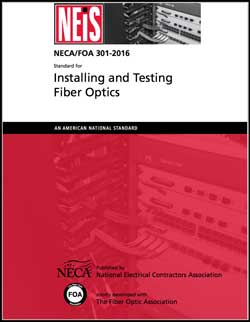
Download your free copy of ANSI/NECA/FOA-301
here (PDF)
Older
questions are now available here.
|
Training / FiberU
News and resources to help you learn more and stay
updated.
Find a
listing of all the FOA-Approved schools here.

Free online
self-study programs on many fiber optics and
cabling topics are available at Fiber U, FOA's
online web-based training website.
Free online training at
Fiber U
The FOA has >100
videos on  |
FOA Network Of
Approved Schools Continues To Grow
The
need for more fiber optic networks to support
broadband and wireless/5G networks has led to a
strong demand for more trained and FOA-certified
techs, and that has led to a demand for more
training organizations. FOA has been adding new
schools and certifying new instructors to meet the
demand. Here are two new schools this month and more
added recently.
New this month:
Western Wyoming Community College, FOA Approved School #401
Schools added
recently:
Arrow For Engineering #774, Amman, Jordan
Team Fishel #399, Virginia
School 398, Telecom Tech, Colorado
School 396 Optconn, Boston, MA
School 395 Fiber Wizards
(Knowledge on Demand LLC)
School 393,
Carolina's Solution Group
School 394,
Tri-County Career Center, Nelsonville, Ohio
School
388: Global Com of Sterling, Virginia, USA
School 389. CWA-JATC Telecom Training Center, San
Jose, CA
School 390 Northern Allied Communications,
Nespelem, WA
School 391 Lewis-Clark State College,
Lewiston, ID
School 392 Wallace Community College, Dothan,
AL
Complete listing of FOA Approved Training Organizations
Need A Fiber Optic Course Onsite? Invite an FOA School To Come To You
FOA often gets inquiries from an organization that
has personnel that needs training in fiber optics. Recent inquiries have
included contractors, a manufacturer of high-reliability products using
fiber optics and a cable manufacturer. In many cases, where there are
several people needing training, FOA can recommend a FOA Approved School
and Certified Instructor who will come to their location to teach a
class. The advantage is of course the savings in travel costs if
the class comes to you, but it also offers the opportunity to customize
the course to fit your needs, even use your equipment or work on your
components, so the training is more relevant to those taking the class.
Contact FOA to discuss the idea of a custom, on-site class to see if it will better meet your needs.
FOA/Fiber U
On-The-Job Training (OJT) Program
The
FOA Fiber U OJT program combines online study at
Fiber U with OJT with mentoring by experienced
co-workers and their supervisor to help new employees
develop into FOA-certified technicians in only
one year. Upon completion
of this program, the trainee will be prepared to
take the exam for the FOA CFOT (Certified Fiber
Optic Technician) and/or CPCT (Certified Premises
Cabling Technician), the most widely recognized
fiber optic and premises cabling certifications in
the industry.
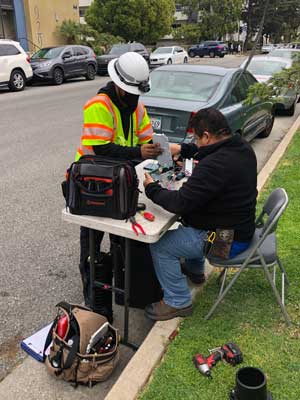
The FOA Fiber U “OJT-To-Cert”
program includes both fiber optics
and premises cabling (copper, fiber & wireless),
so it covers techs working in both outside plant and
premises jobs.
Like other FOA
programs, the OJT-To-Cert program is free. If you
and/or your company is interested in the FOA
OJT-To-Cert program,
contact FOA.
To explain how OJT
works and FOA's OJT-To-Cert program, FOA created a
short 10 minute YouTube video that explains what
OJT is, who uses it and how to use Fiber U to
organize and enhance OJT for new employees and
experienced workers too. Lecture 62: On
The Job Training For Fiber Optics Using Fiber
U
FOA
"Work-To-Cert" Program
Experience Plus
Online Study At Fiber U = FOA Certification
More techs have become comfortable with online
conferences, webinars and training. Many have
discovered that they can become FOA Certified using
their experience in fiber optics and study for the
FOA certification exams online at Fiber U. Thousands of
industry professionals have applied to the FOA
directly for certification without the need for
classroom training, based on their knowledge and
skills developed working the field. Since FOA
certifications are based on KSAs (knowledge, skills
and abilities), current techs already show the
skills and abilities required through their field
experience. FOA provides free online self-study courses at Fiber U for the knowledge
part to prepare you for FOA certification exams
which you can also take online.
If you are an experienced field tech interested in
certification, and FOA is the internationally
recognized certifying body for fiber optics, you can
find out more about the FOA "Work to Cert" program
here.
If you are already a CFOT, FOA also offers many
specialist certifications you can obtain based on
your experience as a field tech. See what's
available at Fiber
U.

Fiber U "Basic Fiber
Optics" Online Self-Study Course Now In Spanish
El curso de
autoaprendizaje en línea "Fibra óptica básica" de
Fiber U ahora en español
El sitio de
aprendizaje en línea de FOA, Fiber U, tiene más de
dos docenas de cursos de autoaprendizaje gratuitos
sobre fibra óptica y cableado de instalaciones.
Como era de esperar, el tema más popular es el
curso "Fibra óptica básica", que se utiliza para
iniciarse en la fibra óptica y como curso de
preparación para realizar el examen de
certificación FOA CFOT.
Ahora el curso básico
de fibra óptica está disponible en español,
utilizando el libro de texto FOA en español, la
sección de la Guía en línea en español y la
capacidad de YouTube para traducir subtítulos de
video al español. El curso funciona exactamente
como la versión en inglés con 10 lecciones, cada
una con cuestionarios y una opción para tomar un
examen de Certificado de finalización.
Para presentar el nuevo curso de
español Fiber U, el examen Certificate of
Completion es gratuito, así que dígaselo a sus
contactos.
Curso Básico de Fibra Óptica
de Fibra U en español.
New Fiber U Course: Fiber Characterization
FOA has added a new course at Fiber U on Fiber Characterization. Fiber
characterization is the process for testing long fiber cable plants for
its ability for carrying high speed communications. With so many
networks now operating at 100, 200, 400 or even 800 Gb/s, fiber
characterization is important, especially on older fiber optic cable
plants.The free Fiber U Fiber Characterization course is available in two forms, as a standalone Fiber U fiber Characterization Course with its own Fiber U Certificate of Completion and as a separate Lesson in the Fiber U Fiber Optic Testing course. This course is recommended for those studying for the FOA CFOS/FC Fiber Characterization certification.
Fiber U MiniCourses: Got An Hour Or Less?
Learn Something New About Fiber Optics.
FOA
has introduced a new type of Fiber U
course, the MiniCourse, a free online course you
could take in a short time, perhaps as you ate lunch
at your desk or took a coffee break. The
topics of these courses should explain what they are
about, and these are all very important topics to
fiber optic techs.
Fiber Optics In Communications
How Optical Fiber Works
Fiber Optic Network
Restoration
Fiber
Optic Connector Identification
Fiber U Color Codes
The Mysterious
dB of Fiber Optics
Fiber Optic Cable Bend Radius
Fiber Optic Link Loss And Power
Budgets
Fiber Optic Connector
Inspection And Cleaning
Fiber Optic Media Conversion
Fiber Optic Cable Midspan Access
Reading An OTDR Trace
Reference Cables For Testing
Fiber Optic Attenuators
The courses have two components, video lectures and
readings, that are complementary. As usual there is
a self-test to allow you to check your
comprehension. As with other Fiber U courses if you
desire, you can take a short test for a Fiber U
Certificate of Completion that costs
only $10.
All these free courses and many more
are available at Fiber U.
What Fiber Techs
Don't Know -
What We Learn From
FOA Certification Tests
As
FOA moves more testing over to our digital online
testing system at ClassMarker, we have access to
more data about our testing, including what
questions and topics on the tests are answered
incorrectly most often. Having this data gives us an
opportunity to evaluate the questions and how they
are stated, but more importantly it allow us to help
our instructors teach the subjects and us to change
our curriculum and online courses to emphasize these
particular topics. These are some of the topics that
we have noticed are answered incorrectly more often
in FOA and Fiber U tests.
Most of the questions missed are on testing.
1. OTDRs - particularly what information is in the
OTDR trace.
2. The difference between dB and dBm
3. Loss budgets - both the concepts and doing the
math
4. Insertion loss testing - single-ended or double
ended for testing patchcords or cable plants, how to
set 0dB references
5. Units of measure - fiber is measured in microns,
wavelengths in nanometers, etc.
At FOA, we're working to add Fiber
U MiniCourses on these topics and working with
our schools to emphasize these topics in their
classes.
If you are going to be taking a FOA certification
course or test in the near future, these topics
should be on your final exam study list.
What We Learn From Hands On Labs
We learn about students performance in hands-on labs
from the feedback of our instructors and our own
experiences too. One big problem is the use of hand
tools. Growing up today, you learn how to use
keyboards, mouses and touch screens, but decades
ago, you also learned how to use basic hand tools.
This is big enough of a problem that we're
considering adding some video lessons on basic hand
tools to prepare students for cable prep,
termination and splicing that require the use of
hand tools.
FOA Guide "Basics Of
Fiber Optics" Now Available Online in Portuguese
(6/2020)

FOA
has now translated the Basics of Fiber Optics
textbook in our Online Guide into Portuguese,
joining Spanish and French translations. For those
speaking Portuguese, we have the technical
information and for schools we also have curriculum
available.
Here is the FOA
Guide in Portuguese,
Spanish
and French
translations.
Time
To Learn - Online
Some
schools have been closed during the pandemic, so FOA
has been working with them to create new online
learning experiences that can in some cases lead to
certification online. FOA certifications are still
based on the KSAs - knowledge from the classroom,
skills from the labs and abilities judged by
instructors or proven by actual experience.
ZOOMing
Much of what we're doing benefits from the
capabilities of "Zoom." Others have created
videoconferencing apps, but none work so well,
especially with limited bandwidth. We've seen remote
labs that have an instructor showing students how to
use the tools they were sent then watching them
duplicate their actions. We have worked out methods
to use Zoom to proctor FOA's online certification
exams.
Blended
Learning
While most FOA schools have suspended in-person
training during this period, some are offering a
"blended learning" option. That means that
students sign up for a FOA certification course,
take the classroom sessions on Fiber U with the
assistance of a FOA certified instructor. Now
online instruction can include reviewing the
labs using the Fiber U Basic
Skills Labs, then when it's possible to attend
classes at the school, complete the hands-on
labs and take the FOA certification exam.
Offline Fiber U
FOA has also created offline Fiber U modules
to allow students with poor or limited
Internet access to use the Fiber U Basic Fiber
Optics and Premises Cabling programs without
Internet access. Contact FOA for information
on using this option.
Online Remote Labs
Alternatively, some schools are experimenting
with "remote labs," where the students get
sent tool kits and components and labs are
conducted by videoconferencing. Before the
labs, the students may watch demos by their
instructor on videoconferencing and/or review
the relevant "virtual hands-on" lessons in the
Fiber U Fiber Optics Basic Skills Labs
so they will already know the steps in the
exercises. And Fiber U has
the new Fiber U
DIY Basic Skills Lab lesson
with directions on how to
purchase inexpensive tools
online and use them to learn
basic fiber optic skills. Videoconferencing
allows the instructor to remotely monitor
their work and provide help as needed. Contact
the FOA for more information.
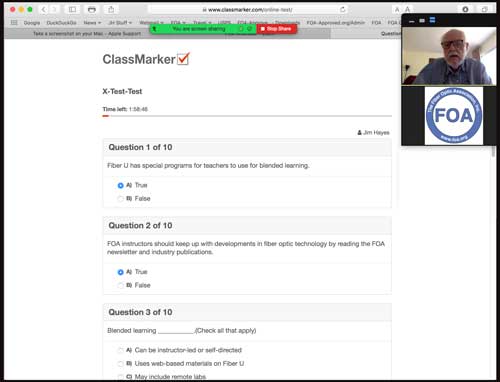
FOA Zoom Exam Proctoring
Online
Certification Testing
FOA has all its certification tests
available online, both for use by our
schools and by our direct "Work
to Cert" applicants. All FOA
certification tests require a proctor to
oversee the applicant taking the exam. In
this time of social distancing, getting a
proctor can be difficult, so FOA now has
procedures for online proctors
administering the exam. Contact
the FOA for more information.
OJT - On-The-Job-Training
Many novices get a job and learn on the job.
They usually have an experienced tech who helps
them gain the knowledge and learn the
skills they need to perform their job. Thinking
about this in relation to the FOA KSAs,
the knowledge, skills and abilities needed by a
fiber optic tech, the tech will learn
skills but not the basic knowledge that helps
them understand the processes involved. FOA can
offer help here with our FOA's
OJT-to-Cert Program,
using our Fiber
U online self-study programs. While the
tech learns on the job, they become a Fiber
U trainee, getting the knowledge they
need, while working under their "mentor" at
work. This is particularly good for
contracting companies who need techs but do
not have the usual training courses
available. Interested in OJT programs? Click
on the link below or contact FOA for
more information.
FOA's OJT-to-Cert
Program

FOA offers free online self-study programs at Fiber U.
Many users are preparing for FOA certification
programs - taking courses at our schools or using
the "Work-to-Cert" program. Some of our
schools are requiring Fiber U programs as
prerequisites for their classroom courses so they
can spend more time on hands-on activities.
FOA School Offers
Toolkit With Online Training
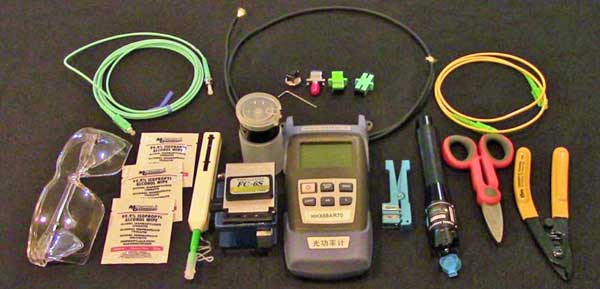
Slayton Solutions
(FOA Approved School #156) is offering a simple
fiber optic tool kit that includes a 29-piece set
of fiber optic tools and a power meter along with
training videos and online instruction for only
$499. 29 Piece Kit includes all tools and devices
a technician needs to install fiber optic
connectors and test optical power. Information on the kit is
available on YouTube. You can contact them for
more information at slaytonsolutions@sbcglobal.net
or https://www.fiberopticsinstitute.com
|
Publications /
Resources

|
Planning A Fiber Optic Project?
The FOA Guide To Fiber Optic Projects includes this timeline and comments on project planning and implementation.
More New FOA Video
Lectures On YouTube
Did you know YouTube
will close caption videos in many languages?
Here are directions.
FOA YouTube Video Describes
On-The-Job Training (OJT)
Lecture
62: On The Job Training For Fiber Optics Using
Fiber U
To
explain How OJT works and FOA's OJT-To-Cert program,
FOA created a short 10 minute YouTube video that
explains what OJT is, who uses it and how to use
Fiber U to organize and enhance OJT for new
employees and experienced workers too.
More New Videos
Including FTTH Series
As part of developing the new Fiber U MiniCourses,
we added several new YouTube videos:
Lecture 56 explains the issues of cable bend radius
limitations, typical cable specifications and how to
gage the proper radius or diameter when installing
or storing cable. Lecture 57 covers problems with
dirty connectors and how to inspect and clean them.
4
New Lectures on FTTH - #63-66 Plus #70 on Rural Broadband
New Lecture on Fiber Optics at Electrical Utilities
- #67
FOA Lecture 51 Fiber
Optic Restoration Part 1 - Causes of
Damage To The Network
FOA Lecture 52 Fiber Optic
Restoration Part 2 - Planning For
Restoration
FOA Lecture 53 Fiber Optic
Restoration Part 3 - Troubleshooting
And Repair
FOA Lecture 54 Fiber Optic
Connector Identification - New and old
FOA Lecture 55 The
Mysterious dB of Fiber Optics. -
Understanding dB
FOA Lecture 56 Fiber Optic Cable -
Bend Radius -
Important for Installers to Understand
Like all our YouTube lectures, they are
all short and easy to understand.
Did
you know YouTube will close caption videos in many
languages?
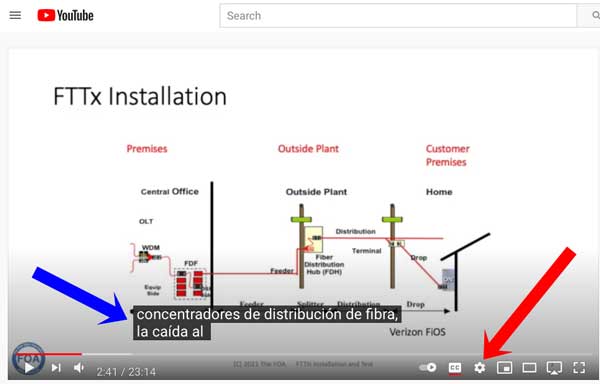
Sign in with Google to get translations for closed
captioning. Click on the settings icon (red arrow.)
Choose "Subtitles". English is the default
language. Click on the arrow after "English
(auto-generated) >". In the new window click on
"Auto-translate" and choose the language you
want.
FOA Loss Budget
Calculator On A Web Page 5/2020
FOA
has written many articles about loss budgets,
something everyone involved in fiber optics needs to
know and needs to know how to calculate. We recently
discovered how to get a spreadsheet ported to a Web
page, so we created this web page that calculates
loss budgets. We have an iOS loss budget app, but
with this web page, you can calculate loss budgets
from any device, smart phone, tablet, laptop, or
desktop computer that has web browsing capability.

Bookmark this page (especially on your
smartphone): FOA Loss Budget Calculator
Online
 We are continually updating the Online Reference
Guide to keep up with changes in the industry and
adding lots of new pages of technical information.
When you go to the FOA
Guide Table of Contents to see the latest
updates - look for
We are continually updating the Online Reference
Guide to keep up with changes in the industry and
adding lots of new pages of technical information.
When you go to the FOA
Guide Table of Contents to see the latest
updates - look for  . .
Recent updates:
FTTH
Updates: Added a section on FTTH Network Design,
updated Architecture and PONs (10G)
Color Codes For Fiber Optics
Fiber
Optic Projects - the FOA Guide to projects from
concept to operation
Coherent Communications Systems in
the FOA Guide.
Go
to The FOA Online Fiber Optic
Reference Guide.
FOA Reference Books
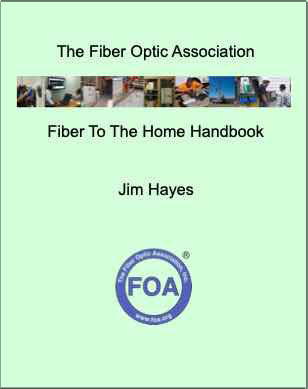
NEW:
FOA's FTTH Handbook: We've
gathered all our information on FTTH from the FOA
Guide and past issues of the FOA Newsletter and
edited it into a 112 page "FTTH Handbook." We even
added a section on planning and managing FTTH
Projects.
The Fiber Optic Association
Fiber To The Home Handbook is
available from Amazon in print and Kindle
editions.
 
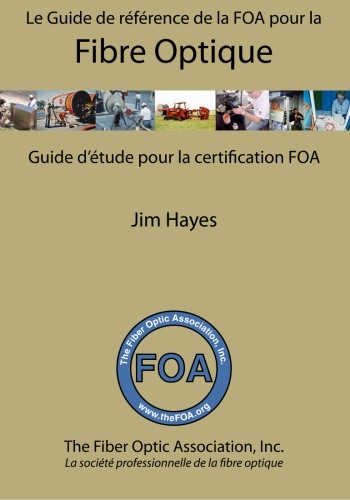      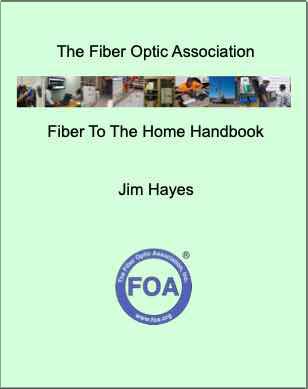
Fiber Optics (4 languages), Premises Cabling, OSP
fiber and construction, Network Design, Testing and
FTTH
The FOA has it's own
reference books for everyone working in fiber
optics - contractors, installers and end users as
well as for use as textbooks in classes at
educational institutions. They are available as
printed books or Kindle at much lower prices than
most textbooks since we self-publish and sell
online, cutting out the middlemen. Click on the
book images for more information. The Reference
Guide To Fiber Optics is also available in Spanish
and French (print and online) and Portuguese
(online only.)
Click on any book for more information
about it.
FOA
has reprinted

"Lennie Lightwave's Guide"
on its 25th anniversary in a special print
edition.
Lennie
and Uncle Ted's
Guides are online or as free iBooks on iTunes.


Click on any of
the books to learn more.
- Fiber
Optic Safety Poster to download and
print
Resources For
Teachers In K-12 And Technical Schools
Teachers in all grades can introduce their
students to fiber optic technology with some
simple demonstrations. FOA has created a page for
STEM or STEAM (science, technology, engineering, arts
and math) teachers with materials appropriate to
their classes. Fiber Optic Resources For
Teachers.
|
Safety
|
On Safety
The FOA is concerned about safety!
FOA
considers safety an integral part of all our
programs, curriculum materials and technical
materials. We start all our textbooks and their
online versions with a section on safety in the
first chapter, like this: Before
we get started - Safety First!
There are pages on the FOA Guide on Safety
procedures Including Eye Safety and. Digging
Safely
And a YouTube lecture: FOA Lecture 2: Safety When Working
With Fiber Optics
In our OSP Construction Section, these pages cover
many safety issues including those related to the
construction of the cable plant: Project Preparation And Guidelines,
Underground Cable Construction,
Underground Cable Installation
and Aerial Cable Installation.
There is even a safety poster for the fiber
activities: PDF Safety Rules For Fiber Optics
Other Safety Resources:
There is a toll-free
"call before you dig" number in the USA: Dial 811. See www.call811.com
for more information in the US. Here is their map of resources by states.
In Canada, it's "Click Before You Dig.com" They also have a page of resources by US states and Canadian provinces.
The Common Ground
Alliance has an excellent "Best Practices Guide"
online
- The US Department
of Transportation has a website called "National
Pipeline Mapping System" that allows one
to search for buried pipelines.
Why We Warn You To
Be Careful About Fiber Shards

Photo courtesy Brian Brandstetter,
Mississauga Training Consultantcy
Safety Leader
Magazine
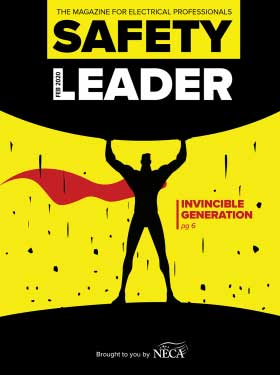
Safety Leader, a new quarterly magazine, informs and
educates electrical contractors on safety from
various angles—electrical, workplace, PPE,
regulations, leadership, line work, NFPA 70E, and
more. Safety Leader is bundled with ELECTRICAL
CONTRACTOR in February, May, August and November. To
receive Safety Leader subscribe to ELECTRICAL CONTRACTOR
magazine here or subscribe to the ELECTRICAL
CONTRACTOR newsletter here.
2023 Conference On
Damage Prevention In Tampa

Global Excavation Safety Conference Tampa, Florida
February 14-16, 2023
GlobalExcavationSafetyConference.com:

The magazine, dp-Pro, sponsor of the conference,
has also published it's latest issue with an
article by FOA on "New Construction Techniques
in Fiber Optics" and a overview of the FOA. You can read the magazine here.
When You Bury Marker
Tape, Bury One That Will Work (July 2021)
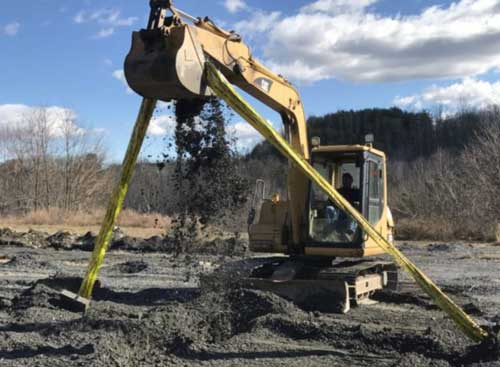
Signaltape® provides a visual
warning by ensuring tape is brought to the surface,
alerting the operator to the presence of a buried
utility. It includes a 3,000-lb. tensile strength
aramid fiber membrane, which ensures the tape is
pulled to the surface to alert the excavation crew.
Signaltape
comes in two sizes: 12″ x 1000′ or 6″ x
1000′.
FOA
Corporate Members - Products & Services
List
of corporate member information provided by FOA
corporate members listed on the FOA website.
|
FOA/About
About The FOA
- Contact
Us: http://www.foa.org
or email <info@foa.org>

FOA has a company page
and four LinkedIn Groups
FOA
- official company page on LinkedIn
FOA
- covers FOA, technology and jobs in the fiber optic
marketplace
FOA
Fiber Optic Training - open to all, covers
fiber optic technology and training topics
Grupo de La Asociación de
Fibra Óptica FOA (Español)
|
What is The FOA?
The FOA is a, international non-profit
educational association chartered to promote
professionalism in fiber optics through education,
certification and standards.
Founded in 1995 by a dozen prominent fiber optics
trainers and leaders from education, industry and government as a professional society for fiber
optics and a source of independent certification,
the FOA has grown to now being involved in numerous
activities to educate the world about fiber optics
and certify the workers who design, build and
operate the world's fiber optic networks.
Read More
FOA History
FOA Timeline of Fiber Optics
FOA was 25 years old
July 2020 - Read about FOA's history
Learn
More About FOA's History.
Contact
Us
The Fiber Optic Association Inc.
http://www.foa.org or email
<info@foa.org>
The
FOA Home Page

Want to know more about fiber optics? Study
for FOA certifications? Free
Self-Study Programs are on "Fiber U®."
Looking for specific information? Here's the largest
technical reference on the web: The
FOA Online Fiber Optic Reference Guide.

Free online self-study programs
on many fiber optics and cabling topics are
available at Fiber U,
FOA's online web-based training website.
|
-
Contact Us
The Fiber Optic Association Inc.
http://www.foa.org or
email <info@foa.org>
- Phone:
1-760-451-3655
The FOA Home Page
Fiber Optic Timeline
(C)1999-2022, The Fiber Optic Association, Inc.
|
FOA Logo
Merchandise
New FOA Swag! Shirts,
Caps, Stickers, Cups, etc.
The
FOA has created a store on Zazzle.com offering lots
of new logo merchandise. It has lots of versions of
shirts and other merchandise with "FOA," "Fiber U,"
"Lennie Lightwave" designs and more so you should
find something just for you! See FOA on Zazzle.
-
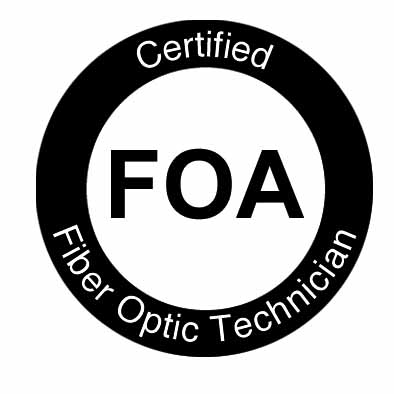
Your
Name, CFOT® - It pays to advertise!
The FOA encourages
CFOTs to use the logo on their business cards,
letterhead, truck or van, etc. and provides logo
files for that purpose. But we are also asked
about how to use the CFOT or CFOS certifications.
Easy, you can refer to yourself as "Your Name,
CFOT" or "Your Name, CFOS/T" for example.
Feel free to use the
logo and designations to promote your achievements
and professionalism!
Contact
FOA at info@thefoa.org to get logos in file format
for your use.
Privacy Policy (for
the EU GDPR): The FOA does not
use cookies or any other web tricks to gather
information on visitors to our website, nor do
we allow commercial advertising. Our website
hosts may gather traffic statistics for the
visitors to our website and our online testing
service, ClassMarker, maintains statistics of
test results. We do not release or misuse any
information on any of our members except we will
confirm FOA certifications and Fiber U
certificates of completion when requested by
appropriate persons such as employers or
personnel services.
Read
the complete FOA Privacy Policy here.
|






























































 .
.







